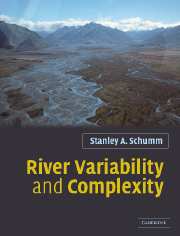Book contents
- Frontmatter
- Contents
- Preface
- Acknowledgments
- Part I Background
- Part II Upstream controls
- Part III Fixed local controls
- Part IV Variable local controls
- Part V Downstream controls
- Part VI Rivers and humans
- Chapter 18 Applications
- Chapter 19 Some unintended consequences
- Chapter 20 River impact on ancient civilizations: a hypothesis
- References
- Index
Chapter 19 - Some unintended consequences
Published online by Cambridge University Press: 05 June 2012
- Frontmatter
- Contents
- Preface
- Acknowledgments
- Part I Background
- Part II Upstream controls
- Part III Fixed local controls
- Part IV Variable local controls
- Part V Downstream controls
- Part VI Rivers and humans
- Chapter 18 Applications
- Chapter 19 Some unintended consequences
- Chapter 20 River impact on ancient civilizations: a hypothesis
- References
- Index
Summary
In Chapter 8, the consequences of human activities on rivers were discussed in passing. Here, some unintended consequences of river modification will be considered. For example, the meander cutoff program on the Mississippi River resulted in a straighter navigation channel but it also resulted in bank instability and the expenditure of vast amounts of money to stabilize the straighter, steeper channel. In addition, the changes of the Platte River, as its hydrology was altered (Chapter 7), and the increased flood stages of the Middle Mississippi River (Chapter 8) as the channel was confined by levees, are all examples of the unintended consequences of human activities.
Even the increase or decrease of gravel in a channel can significantly impact a river. Students of gravel bed rivers are well aware of the protective qualities of a gravel armor. It is perhaps less well recognized that small amounts of gravel in sand-bed rivers can have significant sediment transport and morphological effects. The Missouri and Nile rivers will be used to illustrate other impacts of small amounts of gravel on the morphology and response of sand-bed rivers.
For example, development of an armor significantly reduces bedload transport in a Swiss river. This was demonstrated experimentally by Begin et al. (1980). In a large flume filled with sediment that contained only 1.2 percent of sediment larger than 2 mm, base-level was lowered in order to determine how sediment production changed with channel incision.
- Type
- Chapter
- Information
- River Variability and Complexity , pp. 173 - 181Publisher: Cambridge University PressPrint publication year: 2005



